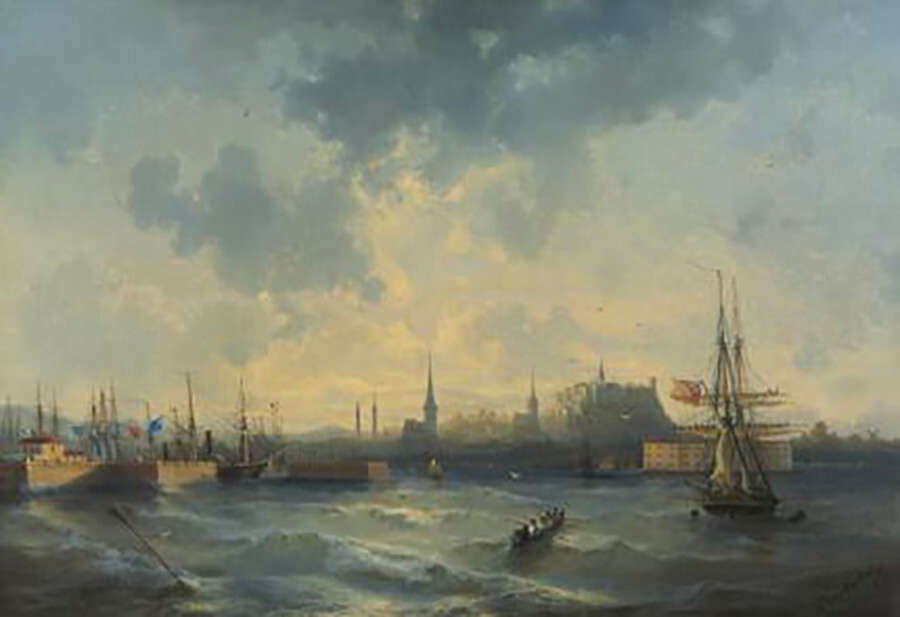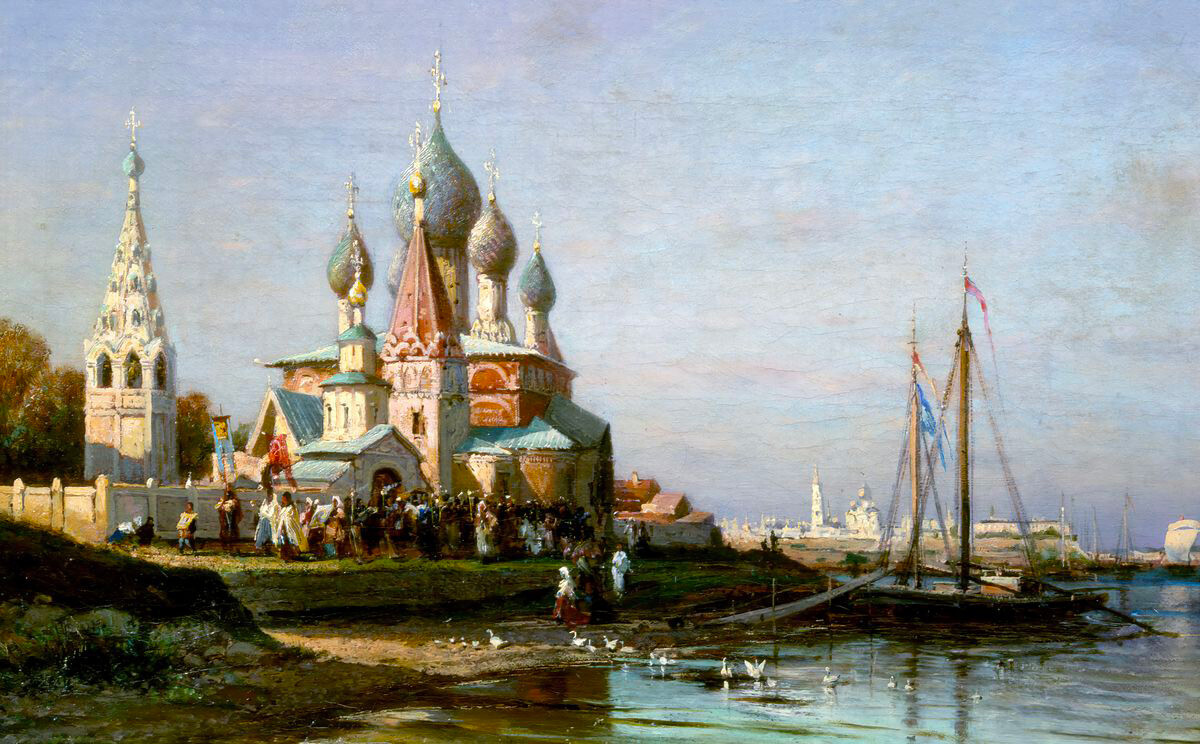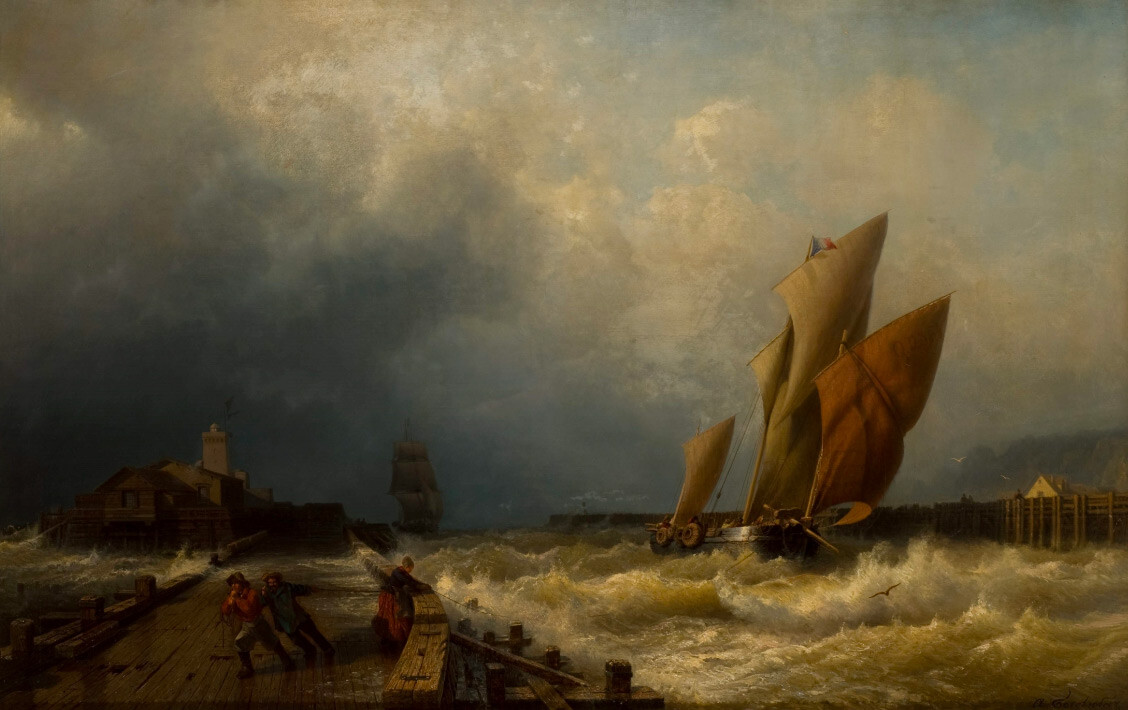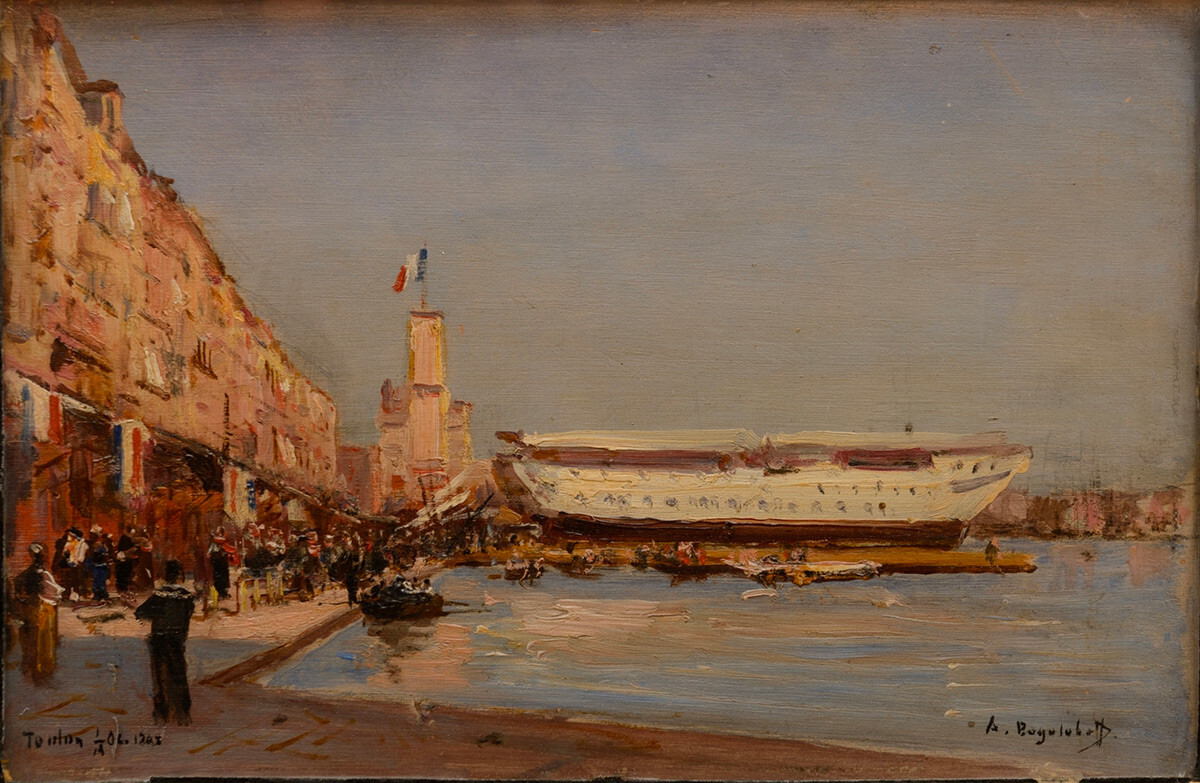
Having graduated from the Naval Cadet Corps, Alexey Bogolyubov (1824-1896) joined the navy. His service and noble parties, however, couldn’t prevent him from dedicating enough time to his main passion – painting, which also helped him make ends meet. The young amateur drew sketches of ship equipment, caricatures and, eventually, even received his first state order.
On a series of voyages, the journey to Madeira in 1848 became fateful – meeting venerable painter Karl Bryullov on the island, Bogolyubov received positive feedback from him on his works. After that, Bogolyubov found himself under the tutorship of Maximilian, Duke of Leuchtenberg, president of the Imperial Academy of Arts, who advised him to seriously take up painting.
Some time later, he joined the Academy as an external student, while remaining in service to have some funds for living. In 1853, the painter received a ‘Big Gold Medal’ for three views of Revel and for ‘View of St. Petersburg from the Seaside’.

The award of the Academy gave him the right for a pensioned trip overseas. By that time, he had already left his service in the navy and he departed for Venice in October 1854.
“The warm Venetian evening descended, full moon appeared as if on purpose, the night fell like a curtain, and here’s when I liked Venice even more. Black gondolas turned the surface of the Grand Canal and the lagoons silver. Everything lay touched with a thin blueish veil,” he described his impressions in ‘Notes of a Sailor-Artist’; in them, he also confessed that he would paint this city for the rest of his life. Indeed, he painted and drew no less than a hundred of its views.

Bogolyubov spent six years overseas, studying the masterpieces of world art, improving in painting by learning from his foreign colleagues. In Paris, he graduated from the school of Couture and learned from famous marine painter Eugène Isabey, the court painter of the King of France, Louis-Philippe I; he became acquainted with Jean-Auguste-Dominique Ingres and, later, also with Corot, Daubigny and Rousseau.
In Dusseldorf, he learned the secrets of realistic painting at the workshop of landscape painter Andreas Achenbach; under his supervision, he created several large paintings, including ‘A Fair in Amsterdam’, a pervasive work, which symbolically summarized his pensioned trip.
Bogolyubov returned to Russia at the end of 1860 with a whole lot of paintings and studies that were exhibited at the Academy with great success, which solidified his status as a great artist. Emperor Alexander II paid handsomely for ‘A Fair in Amsterdam’ and for all paintings about the Crimean War of 1853-1856 and gave the artist a new commission – to paint the history of naval battles of Peter the Great.

In his era, he acquired the fame of a marine painter, the master of battle scenes, knowing no equal, thanks to his experience as a naval officer. He painted the scenes of naval battles, beginning from the times of Peter the Great and ending with the events of the Russo-Turkish War of 1877-1878. He worked on his Peter the Great series in the 1860s-1870s, constantly moving between countries.
This painting shows the scene of the first victory of the Russian fleet at sea, right at the moment when Russian flagship ‘Portsmouth’ releases a volley at a Swedish ship. This sketch, among other works, Bogolyubov gave to the Radishchev Museum in Saratov, which he himself founded. The museum was opened in 1885 and became the first public museum in Russia outside the capital.
The founding of this museum was a life’s work for the painter; he put a lot of effort into giving this museum the name of his grandfather – disgraced writer Alexander Radishchev, the author of ‘Journey from St. Petersburg to Moscow’. In many ways, his friendship with Emperor Alexander III contributed to this; however, people in the emperor’s inner circles gossiped for a long time about the grounds for naming a museum after a revolutionary. However, it stood, and Bogolyubov bequeathed his possessions and 200,000 rubles to the museum.

In 1861, the painter, with his brother Nikolai, a sailor and a writer, embarked on a journey along the Volga River to create a travel guide for the region. For Bogolyubov, who had spent a long time living overseas, this was an acquaintance with his own country, which, according to the painter himself, was difficult to comprehend. To his surprise, there were more than 20 religious processions in Yaroslavl, starting from the celebration of the Baptism of Jesus and proceeding into late fall.
This topic captured him and became one of the central themes in his artistic work. A couple of years later, Bogolyubov spent five days in Yaroslavl as part of the retinue of Grand Duke Nicholas Alexandrovich, who purchased his works.
After the untimely death of the tsesarevich, these paintings ended up in the collection of future emperor Alexander III, who, as it’s known, inherited not only the paintings from his older brother, but also his fiance - Princess Dagmar of Denmark, future Empress Maria Feodorovna.

Bogolyubov was not just one of the favorite painters of Alexander III, but also his friend, as well as Maria Feodorovna’s painting tutor. He also excelled in forming the emperor’s collection, who gathered about 800 items placed in different palaces.
In 1870, as a sign of appreciation, Alexander III placed about thirty paintings by Bogolyubov in the dining room of the Alexander Palace and called this room the ‘Bogolyubov Hall’. This painting was in Alexander III’s office in the Anichkov Palace, his residence.

After 1873, Bogolyubov permanently lived and worked overseas, due to a heart condition, only rarely returning to his homeland. That didn’t prevent him from being informed of all the affairs or from participating in the ‘Peredvizhniki’ exhibitions; using his administrative resources, he also helped other artists.
For example, in 1885, he successfully appealed to remove the ban from Ilya Repin’s painting ‘Ivan the Terrible and His Son Ivan on 16 November 1581’, which Alexander III didn’t like. He also arranged lucrative commissions for other artists, including Polenov, Savitsky, Kramskoy. Russian artists in Paris floated between Bogolyubov’s workshop on Rue de Rome, 95, which was called the ‘Russian Paris’, and the house of singer Pauline Viardot, where yet another of her patrons, author Ivan Turgenev, organized events to support Russian youth.
The apotheosis of ‘Tuesdays’ at Bogolyubov and ‘Thursdays’ at Turgenev was the founding of the ‘Community of Mutual Help of Russian Painters’ in Paris. At the same time, the organization of an alliance between the Russian Empire and the French Third Republic was underway. After the arrival of a French squadron in Kronstadt, a Russian squadron of Admiral Avellan departed to Toulon in 1893, which became the key event in bringing the countries together and in the signing of the Franco-Russian Alliance. By that time, Bogolyubov had become the main figure in cultural connections between France and Russia, so he was elected by the tsar as the official artist to capture the ceremonies in Toulon. Not long before his death he became a recipient of the National Order of the Legion of Honor.
Dear readers,
Our website and social media accounts are under threat of being restricted or banned, due to the current circumstances. So, to keep up with our latest content, simply do the following:
If using any of Russia Beyond's content, partly or in full, always provide an active hyperlink to the original material.
Subscribe
to our newsletter!
Get the week's best stories straight to your inbox